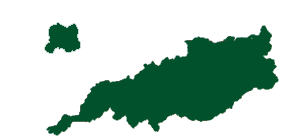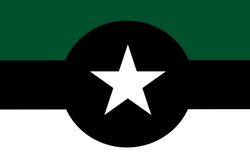Swinas
Unitary Republic of Swinas | |
|---|---|
 | |
| Capital | Cape Cresta City |
| National Language | German, Common |
| Ethnic groups |
|
| Demonym(s) | Swish |
| Government | Unitary Republic |
• President | Amelia Norris |
| Population | |
• 2021 census | 42,299,153 |
| GDP (nominal) | estimate |
• Total | 448,984,350,000 |
| Currency | Swish Ram, Swish Buckling (SR, SB) |
| Driving side | right |
| Calling code | +59 |
The Unitary Republic of Swinas, or Swinas for short, is a country with a diverse landscape that includes the temperate climate and varied terrain of North Swinas, as well as the mostly desert landscape of South Swinas. The country's biggest city and capital is Cape Cresta City, located in North Swinas. Swinas is situated near the middle of the Hiraethia continent and has a growing interest in space exploration. Additionally, Swinas has a unique cuisine that's famous for its unusual pizza toppings. The history and culture of Swinas are shaped by the contrast between the North and South regions, as well as the heritage of the indigenous people of South Swinas. Swinas offers a fantastic blend of natural beauty, delicious food, and technological advancements that make it an exciting and distinctive destination for tourists and researchers alike.
History
Prior to the arrival of Riamese colonizers, the deserts in South Swinas were under the control of the Kawhaibia Dynasty, an indigenous tribe with a rich cultural history. The Kawhaibia people had developed unique methods of survival and adaptation to the harsh desert environment, building a prosperous civilization. Emperor Annikki was the final ruler of the Kawhaibia Dynasty and, according to local accounts, he politely handed over the crown to the Riamese and walked away. This peaceful surrender allowed for a smooth transition of power and allowed the Kawhaibia people to maintain significant autonomy and cultural preservation under Riamese rule. Today, the legacy of the Kawhaibia Dynasty remains an important part of the cultural identity of South Swinas and its people.
In the early 20th century, Swinas saw the arrival of Riamese explorers and traders, marking the beginning of Riamese colonization in the region. Initially, the Riamese encountered a friendly welcome from the indigenous tribes, who were open to establishing trade and cultural exchange. This led to the establishment of settlements and trading posts, which acted as a base for the Riamese to expand further into the interior. With colonization came the introduction of new technologies, religions and cultures, and also positive developments such as education and healthcare. Despite these changes, the Riamese and the indigenous people of Swinas maintained a peaceful coexistence. This allowed both cultures to learn from one another and benefit from their interactions, creating a mutually beneficial relationship. The result was a relatively smooth transition of power and significant autonomy for the indigenous people of Swinas, preserving their cultural identity under Riamese rule. The legacy of this peaceful coexistence continues to play an important role in the cultural identity of South Swinas and its people.
In 1915, Swinas gained its independence from Riamo, signaling the end of colonial rule and the beginning of its journey as a sovereign nation. The process of gaining independence was relatively peaceful, as the Riamese government had already begun to release several of its colonies at that time. Independence Day is a national holiday in Swinas, celebrated every 15th of September to commemorate the country's freedom. After gaining independence, the country faced the daunting task of nation-building, which included establishing a stable government, fair legal system, and diversified economy. Despite the challenges, Swinas continued to grow and develop as a sovereign nation, with a rich history and culture that continue to shape its identity today.
Following the achievement of independence from Riamo in 1915, Swinas faced the monumental task of constructing a new nation. To determine the most suitable political system for the country, a referendum was conducted, ultimately leading to the establishment of a Federal Republic. This decision was made to ensure a degree of autonomy and representation for the various regions in the government. The country's leaders concentrated on creating a stable government, establishing an effective legal system, and implementing an economy that would cater to the needs of all citizens. In the early post-independence years, the government invested heavily in the development of the country's infrastructure, such as transportation, communication, and energy systems. Furthermore, significant investments were made in education and healthcare, leading to a better quality of life for the citizens. Despite encountering economic and political obstacles, the country succeeded in creating a stable and prosperous nation, laying the foundation for future development.
The Swish Civil War was a major event in the history of Swinas, occurring in the late 1920s, after the country gained its independence. The war pitted socialist and democratic factions against one another, with the democratic faction, led by the Swish Democratic Faction, emerging as the victor. The conflict resulted in a significant loss of life and widespread destruction of property, causing severe economic damage to the country. Following the war, the country's leaders worked tirelessly to rebuild and establish stability, a fair legal system, and a diversified economy. The causes, events, and aftermath of the war have been extensively researched and documented by historians, with more information available on the Swish Civil War page. The impact of the civil war on the political, social, and economic landscape of Swinas continues to be felt to this day, and its legacy has played a significant role in shaping the country's history and identity.
Following the victory of the Democratic Faction, efforts were made to arrest any remaining Socialists in Swinas. To achieve this, reserve forces of the Civil War were deployed to the former socialist territories to crack down on socialism in the area. This period was later referred to as "De-Socialism" and was successful in some areas, but largely unsuccessful in others. In some cases, the reserve forces faced armed resistance from some socialists, making it difficult to enforce this policy. Even in the small village of Hytra, some socialists attempted to restart the civil war, although their efforts quickly failed. This resistance demonstrated the challenges faced by the reserves in carrying out their duties.
In the aftermath of the war, the country's leaders worked to establish stability, a fair legal system, and a diversified economy. Despite their efforts, some residual socialist elements within the country remained, and the Swish Democratic Faction made it a priority to neutralize these threats. They did so by sending reserve forces of the Civil War into former socialist territory and cracking down on any remaining socialist activities. This period became known as "De-Socialism" and was met with varying levels of success.
Politics
Amelia Norris
During the elections of 2021, Amelia Norris, a Liberal Politician, ran for president of the formerly Federal Republic of Swinas. She campaigned on a platform of unity and modernization, emphasizing her commitment to improving the lives of all citizens and fostering a sense of national pride. Her campaign was fierce and competitive, as she faced several strong candidates from different political parties. Despite this, Amelia Norris emerged victorious, winning a majority of the votes in the election. With her victory, she became the 3rd woman to become president of Swinas. Her win was seen as a significant milestone in the country's political history, as it demonstrated the increasing participation and influence of women in the political sphere. Her presidency was marked by a number of significant reforms and achievements in areas such as education, healthcare, and infrastructure development, as well as uniting all the Swish provinces into one singular state.
Foreign Relations
The Unitary Republic of Swinas has a history of good relations with other countries, particularly with the democracies of Hylia and Trident Union, both are non-bordering countries. These countries have strong diplomatic ties, with regular high-level visits and meetings between government officials. The countries also have a strong economic partnership, with a significant amount of trade and investment taking place between them.
Swinas and Hylia have a long-standing friendship, founded on shared values such as democracy, human rights and free trade. They have cooperated on various international issues, such as peacekeeping operations and humanitarian aid, and have a strong relationship in cultural exchange.
Trident Union, being a faraway country, also has a strong relationship with the country. The two countries have a mutual defense agreement and have cooperated on various issues such as counterterrorism, drug trafficking and illegal migration. Swinas and Trident Union also have a strong economic partnership, with many Swish companies investing in Trident Union and vice versa.
Swinas also maintains cordial relations with other countries in the region and is active in regional organizations such as the Anterian Peace League. Overall, the Unitary Republic of Swinas is committed to promoting peace and stability in the international community and has a history of maintaining good relations with other countries. The country's foreign policy is based on the principles of non-interference, mutual respect, and cooperation with other nations.
Economy
For a brief period of time after independence in 1915, Swinas kept the Riamese currency. However, with the help from the Riamese, the country soon established its own currency, the Swish Ram, named after an old goat religion that was practiced by the indigenous people of Swinas. The Swish Ram quickly became the main currency used throughout the country, and it was widely accepted by merchants and businesses. In addition to the Swish Ram, the country also established the Swish Buckling, which was used for the paying of non-dollar increments. This system helped to ensure that the country's economy was stable and that the currency was easily accessible to all citizens. Today, the Swish Ram and the Swish Buckling are still in use and continue to play an important role in the country's economy.
Geography
Environment
Swinas has taken various measures to preserve and protect its natural resources. One of the key steps taken by the government is the establishment of national parks and nature reserves to safeguard the country's flora and fauna. Swinas has a total of 28 protected areas covering a vast area of land, including forests, wetlands, and marine ecosystems.
Furthermore, Swinas has implemented strict regulations on logging and mining to prevent deforestation and environmental degradation. The country has also invested in sustainable forestry practices, such as selective logging and reforestation programs, to ensure the long-term health of its forests. The government has also encouraged the use of alternative energy sources, such as solar and wind power, to reduce the reliance on non-renewable energy sources.
In addition, Swinas has implemented policies to reduce pollution and improve air and water quality. The government has implemented regulations on vehicle emissions, and industrial facilities are required to meet stringent environmental standards. The country has also invested in wastewater treatment facilities to ensure that wastewater is treated before being released back into the environment.
Overall, Swinas is committed to preserving and protecting its natural resources for future generations. The country's efforts to promote sustainable development have not only helped to preserve its unique ecosystems but have also created new opportunities for eco-tourism and sustainable economic growth.
Rivers
Swinas is blessed with two major rivers, the Dandora and the Kishwara, which play a vital role in the country's ecosystem and economy.
The Dandora River is the longer of the two, stretching over 600 kilometers from its source in the highlands of the north to its outlet in the Talsar Sea. Along its course, the Dandora provides a lifeline for both human and animal communities, with countless towns and villages settled along its banks. The river also supports a wide range of agricultural activities, with farmers utilizing its fertile floodplains for rice, sugarcane, and other crops.
The Kishwara River, on the other hand, is relatively shorter, but no less important. It begins in the hills of the west and flows through dense forested areas and rocky terrain, creating stunning waterfalls and providing habitats for a variety of wildlife. The river is also a critical source of water for many communities in the region, supplying clean water for drinking, cooking, and washing.
Despite their importance, both rivers are facing numerous threats, including pollution from industrial activities, agricultural runoff, and urbanization. To combat these threats, the Swinas government has implemented several measures to protect the rivers and their surrounding ecosystems. These measures include the creation of protected areas and conservation zones, the establishment of monitoring programs, and the enactment of laws and regulations to control pollution and other harmful activities.
The government has also encouraged community-based initiatives to protect and conserve the rivers. For example, local organizations have been established to clean up the rivers and their surroundings, plant trees to prevent soil erosion and promote biodiversity, and educate the public about the importance of protecting these precious resources.
Overall, the Dandora and Kishwara Rivers are essential components of Swinas' natural heritage, and their protection and conservation are vital for the country's sustainable development.





